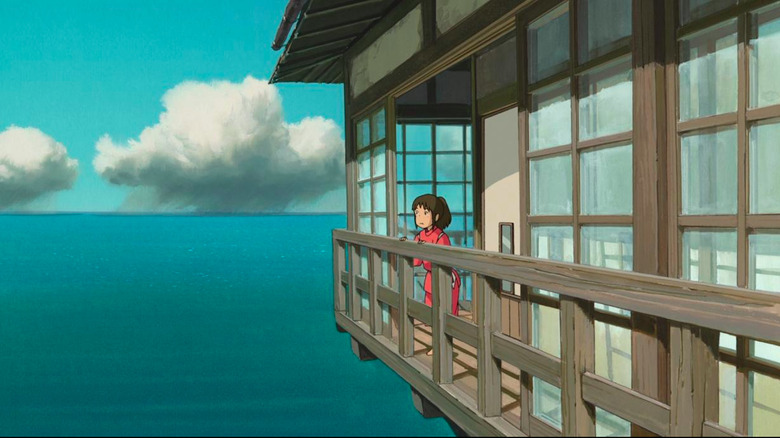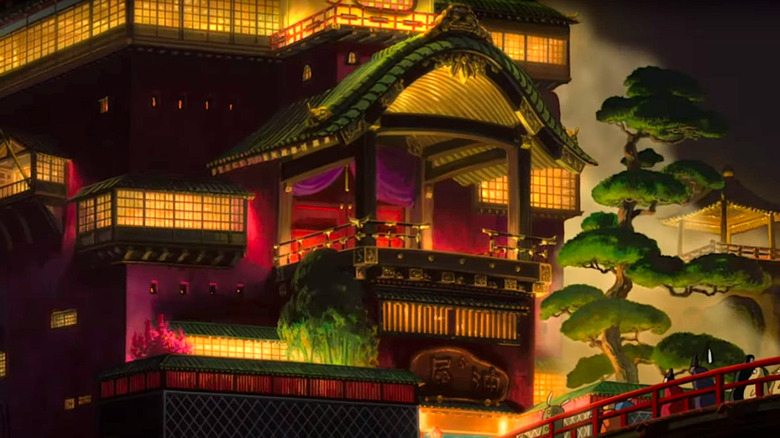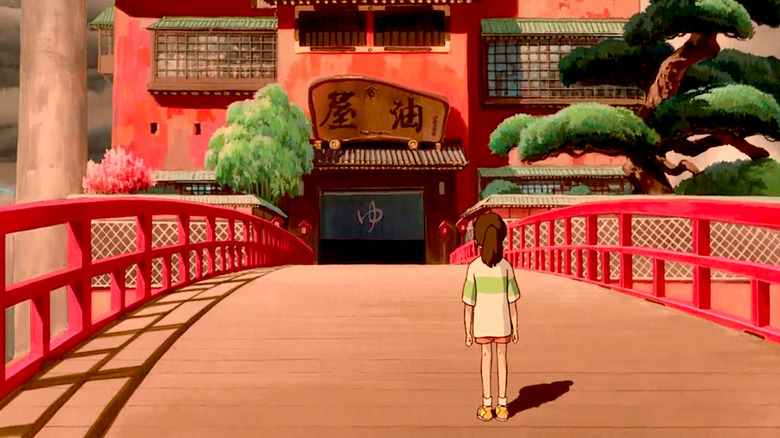How Hayao Miyazaki Found The Setting For Spirited Away
If you're a fan of Studio Ghibli, you've no doubt seen the news that the Ghibli theme park has officially launched its website along with a whimsical trailer offering a sneak peak inside the park. The park looks breathtaking, inviting its visitors to "take a stroll, feel the wind, and discover the wonders" that it has to offer. It boasts a lack of large theme park rides in exchange for a more environmental, exploratory experience.
Hayao Miyazaki, the creator behind many of Studio Ghibli's films, has often talked about his belief in the importance of nature in a child's life. This devotion to the natural world will be reflected in the new park when it opens in November, and it has been a longtime theme in many of Miyazaki's works. "Spirited Away," a film about a young girl Chihiro who goes in search of her missing parents only to find herself working at a lively bathhouse for spirits, does a lot to show respect for the Earth.
But just what was the inspiration behind the breathtaking scenery in "Spirited Away," a film that seems to blend both the natural and the manmade in its visuals? Much of the film takes place inside an ornate bathhouse, but there is also a deep respect paid to more natural landmarks like rivers and oceans (Haku hive assemble!). The film draws from many different inspirations, and Miyazaki's inspiration for the setting in "Spirited Away" is just as fascinating as you might expect.
A mysterious bathhouse specifically for spirits
In an interview for Animage magazine, Miyazaki talks a bit about his fascination with bathhouses. "For me, a bath house is a mysterious place in town. The first time I saw an oil painting was in a bath house. And there was a small door next to the bath tub. I wondered what was behind that door," he says. Because he found this bathhouse captivating, he wrote "a story about a young man the same age as [Chihiro]," but when it came time to present it as a possible film, the concept was rejected. Still, Miyazaki did not let this discourage him. He maintained his fascination with bathhouses, adamant that there was a story worth telling behind that "small door next to the bath tub."
In Japanese culture, the bath is very important. Its history can be traced all the way back to the 6th century. Seen as a healing ritual for both the body and spirit, bathing is extremely commonplace in Japan. For those familiar with another Miyazaki classic, "My Neighbor Totoro," you might remember the scene where Satsuki and Mei unwind in the bath with their father after a long day of work. To some Americans, this ritual may seem a little odd at first, but for the Japanese it is an extremely common and social activity. "Pen15" is another great show that sheds light on the cultural importance of the bath as there are many scenes where Maya and her mother connect over conversations had while taking a bath together.
Inspired by the mystery of the bathhouse, as well as the Japanese belief that gods often find time to bathe in hot springs as a way to rest and unwind, Miyazaki thought to put two and two together. "I was imagining such things as I made images [of the film]. I was thinking that it's tough being a Japanese god today," he says in Animage.
Going back in time
"Spirited Away" is also unique for its Meiji-era style buildings which seem to blend traditional Meiji architecture with a more western style. This was a purposeful decision on Miyazaki's part, and much of his inspiration for the movie's buildings came from his love of the Edo-Tokyo Open Air Architectural Museum in Japan. He tells Animage that whenever he visits this museum — which he does frequently — he "feel[s] nostalgic here, especially when I stand here alone in the evening, near closing time, and the sun is setting — tears well up in my eyes." He goes on to explain that, "I think we have forgotten the life, the buildings, and the streets we used to have not so long ago."
"Spirited Away" allows its viewers to travel back in time to this era that Miyazaki loves so much. Because the architecture is a blend of traditional Japanese architecture and more western-influenced architecture, it allows for the film's visual landscape to exist in this sort of in-between of the old and the new. Much like the guests of the bathhouse, this sense of being in-between things is a common theme throughout the film, and it was a brilliant move on Miyazaki's part to make the architecture reflect that.
Chihiro is a young girl on the cusp of adolescence. She is fluctuating between the world of a child and the world of an adult. Everything around her, then, must show this transitional effect, and Miyazaki's choice of a mysterious bathhouse from a time period with uncertain architecture goes a long way in reinforcing this concept.


